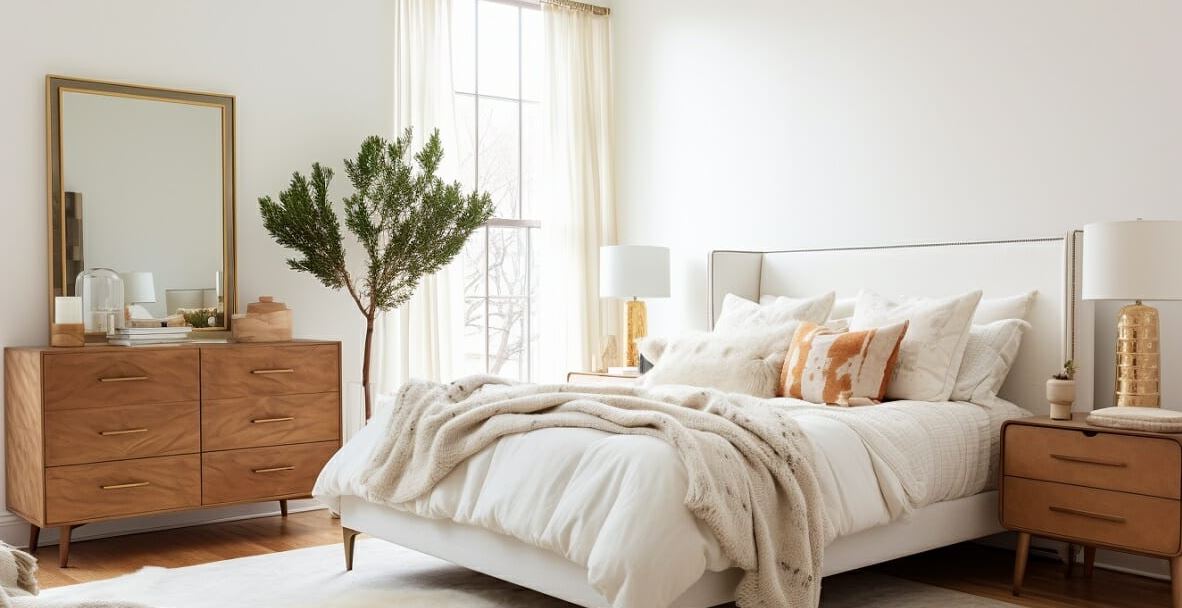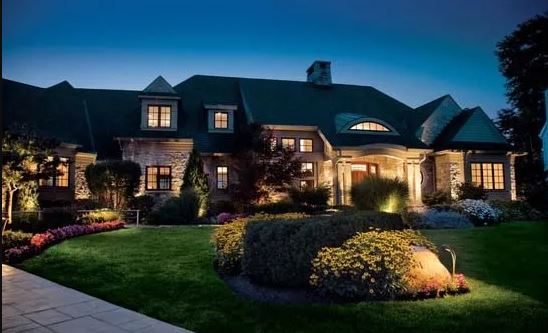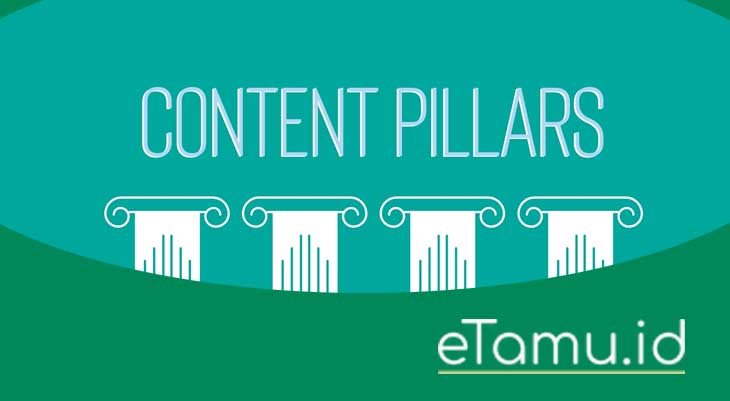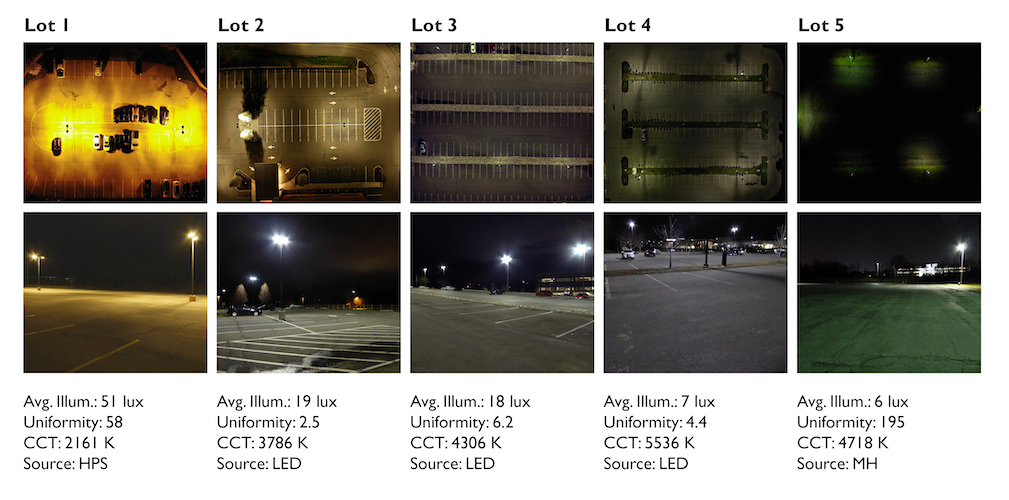Mountain modern cabin design blends the rustic charm of the mountains with sleek, contemporary aesthetics. It’s a perfect retreat, combining comfort and style for those seeking a connection with nature in a sophisticated space. This style goes beyond just a cabin; it’s about crafting a living experience that seamlessly integrates with the surrounding landscape while maintaining a modern feel.
This guide explores the key elements of mountain modern cabins, from architectural choices to interior design, materials, and outdoor spaces. We’ll delve into everything from defining the style itself to understanding sustainable design principles. Learn how to create a truly unique and captivating mountain retreat.
Defining Mountain Modern Cabin
The mountain modern cabin blends the rustic charm of a mountain retreat with the clean lines and sophisticated aesthetic of modern architecture. This style is a popular choice for those seeking a functional and visually appealing dwelling nestled within a natural environment. It emphasizes a harmonious relationship between the interior and exterior spaces, often showcasing stunning views of the surrounding landscape.This style evolved from the desire to create a contemporary dwelling in mountainous regions.
Early influences came from Scandinavian design, known for its focus on simplicity and natural materials, along with the growing popularity of modern architecture, with its emphasis on clean lines and functionality. This combination has led to the distinctive features that define a mountain modern cabin.
Architectural Style
Mountain modern cabins typically feature simple, geometric shapes and clean lines. Large windows are a common element, maximizing natural light and showcasing the surrounding scenery. The exteriors often utilize natural materials like stone, wood, and metal, which blend seamlessly with the mountain environment. Rooflines are usually low-sloped, which is practical for snowy climates. Open floor plans are frequent, creating a sense of spaciousness and connecting interior spaces with exterior views.
Interior Design Elements
The interior design of a mountain modern cabin emphasizes functionality and comfort. Neutral color palettes, such as whites, grays, and beiges, are prevalent, allowing the natural light and stunning views to take center stage. Natural materials, like wood and stone, are incorporated throughout the interior, further enhancing the connection to the outdoors. Modern furnishings, often with clean lines and minimalist designs, complement the overall aesthetic.
Textiles and accents, such as rugs and throws, are carefully selected to add warmth and texture without overpowering the space.
Common Materials
Natural materials are a hallmark of the mountain modern cabin. Stone, both for cladding and accents, provides a strong connection to the surrounding landscape. Wood, used for flooring, beams, and cabinetry, brings warmth and texture. Metal, often in the form of railings, accents, or roofing, adds a touch of modern sophistication. Glass, in large windows and sliding doors, allows natural light to flood the space and showcase the surrounding views.
These materials work in harmony, creating a space that feels both contemporary and connected to nature.
Distinguishing Characteristics
Mountain modern cabins stand apart from other cabin styles through their unique blend of elements. Rustic cabins, for example, often emphasize traditional materials and construction methods, while log cabins are characterized by their exposed logs. Mountain modern cabins, in contrast, employ modern architectural principles, but retain a strong connection to the natural environment through their use of natural materials.
The emphasis on functionality, clean lines, and seamless integration with the landscape distinguishes this style from other cabin types.
Comparison Table
| Characteristic | Mountain Modern Cabin | Rustic Cabin | Log Cabin |
|---|---|---|---|
| Architecture | Clean lines, geometric shapes, large windows, low-sloped roofs | Traditional forms, exposed beams, often a more complex structure | Exposed logs, often with a more traditional or historic feel |
| Materials | Stone, wood, metal, glass | Wood, stone, possibly metal | Logs, wood, stone, metal |
| Interior Design | Neutral color palettes, modern furnishings, natural materials | Warm, earthy tones, often with traditional or antique pieces | Natural wood tones, often with rustic or traditional furniture |
| Overall Aesthetic | Sophisticated, contemporary, and connected to nature | Warm, inviting, and traditional | Rustic, cozy, and often evokes a sense of history |
Interior Design Considerations
Mountain modern cabins prioritize a harmonious blend of rustic charm and contemporary style. This approach often involves thoughtful consideration of natural elements, creating a warm and inviting atmosphere while maintaining a clean aesthetic. The goal is to achieve a space that feels both connected to the surrounding landscape and distinctly modern.Interior design in mountain modern cabins focuses on creating a sense of spaciousness and connection to the outdoors.
Large windows and thoughtful layouts maximize natural light and views, fostering a serene and immersive experience. The choice of materials, colors, and furniture styles all contribute to the overall ambiance, aiming to achieve a balance between the raw beauty of the mountain environment and the comfort of a contemporary home.
Key Interior Design Elements
Natural elements are central to mountain modern cabin design. This means incorporating materials like wood, stone, and natural fibers in a way that enhances the aesthetic rather than overwhelming it. Open floor plans and high ceilings are common to promote a sense of spaciousness, further enhancing the connection with the surrounding environment. Functionality and comfort are equally important, balancing the raw, natural feel with modern conveniences.
Role of Natural Light and Views
Maximizing natural light and incorporating stunning views are paramount in mountain modern cabins. Large windows and strategically placed skylights allow abundant daylight to flood the interior, creating a bright and airy feel. Floor-to-ceiling windows often frame breathtaking vistas, bringing the outdoors in and enhancing the sense of tranquility. Careful consideration of window placement ensures privacy without sacrificing the stunning views.
Mountain modern cabins are all about sleek lines and open spaces, perfect for enjoying the views. They often have similar interior design concepts to a modern loft house, like Modern loft house designs, but with a focus on natural materials and maximizing the connection with the outdoors. Ultimately, a mountain modern cabin is a beautiful blend of comfort and stunning scenery.
Color Palettes, Textures, and Furniture Styles
Common color palettes in mountain modern cabins often feature neutral tones like beige, gray, and muted greens. These colors complement the natural surroundings and create a calming ambiance. Warm wood tones are frequently incorporated, adding a touch of rustic charm. Textures are also carefully chosen to create depth and visual interest. Natural materials like linen, wool, and leather provide a sense of warmth and sophistication.
Furniture styles tend towards clean lines and simple forms, with pieces that are both comfortable and visually appealing. For example, a sleek, modern sofa can be juxtaposed with a rustic wooden coffee table, or a Scandinavian-style dining table paired with leather chairs.
Examples of Color Palettes
| Color Palette | Impact |
|---|---|
| Warm Neutrals (Beige, Cream, Light Gray) | Creates a calming and inviting atmosphere, highlighting the natural elements. |
| Earthy Tones (Muted Greens, Browns, Taupe) | Enhances the connection to the natural surroundings, promoting a sense of serenity. |
| Modern Accents (Deep Gray, Charcoal, Black) | Adds a touch of contemporary sophistication, balancing the rustic elements. |
Incorporating Natural Materials
Natural materials like wood, stone, and metal are crucial to the aesthetic of mountain modern cabins. Wood, in particular, is often used in flooring, cabinetry, and accents, adding warmth and a sense of authenticity. Stone, from countertops to fireplaces, brings a touch of rugged elegance. Metal, like copper or brushed nickel, adds a modern touch to fixtures and accents.
The key is to use these materials thoughtfully, ensuring they complement rather than overwhelm the overall design. For instance, a rustic wooden mantelpiece can be paired with sleek metal sconces for a perfect balance.
Exterior Design Elements
Mountain modern cabins often feature a blend of rustic charm and contemporary aesthetics. Their exterior design is crucial for seamlessly integrating the structure into the surrounding mountainous environment while maintaining a modern aesthetic. This section explores the architectural features, materials, and design considerations essential for achieving this balance.
Architectural Features
The architectural style of a mountain modern cabin is characterized by clean lines, simple forms, and a focus on natural materials. Common features include pitched roofs, often with a slightly steeper incline than traditional styles, which are designed to shed snow effectively. Large expanses of glass, strategically placed windows, and minimalist facades are also prominent elements. These features contribute to the cabin’s openness and connection to the surrounding landscape.
The use of exposed beams or rafters can also be incorporated, adding a touch of rusticity.
Exterior Materials
Choosing the right materials for a mountain modern cabin is critical for both durability and visual appeal. Common materials include: wood (often locally sourced), stone, and metal. Wood, especially in natural finishes, provides a warm, inviting aesthetic and blends seamlessly with the surrounding environment. Stone, in various forms and colors, can create a strong, substantial presence, especially when used as accents or for foundations.
Metal, particularly in finishes like copper or steel, offers a contemporary touch. Properly sealing and treating these materials is essential to ensure their longevity in a mountain environment.
Blending with the Landscape
The goal is to create a cabin that feels like an integral part of the landscape, not an intrusive element. Careful consideration of site location, orientation, and the surrounding vegetation is crucial. Employing natural earth tones and blending the cabin’s color palette with the surrounding rock and foliage is a key element. The placement of the cabin on the property should also take into account views and natural light.
This can involve strategically positioning the cabin to maximize views or integrate it with existing contours of the land.
Mountain modern cabins are all the rage these days, offering a unique blend of rustic charm and modern amenities. They often feature stunning views, and if you’re looking for a similar feel in a less mountainous setting, check out Modern countryside homes for inspiration. Ultimately, the key is finding a space that perfectly blends with the surrounding landscape, no matter if it’s in the mountains or the countryside.
Role of Windows
Windows are crucial in mountain modern cabins. They provide not only natural light but also a direct connection to the stunning views. Large, expansive windows are often used to maximize this connection, allowing the surrounding landscape to become an integral part of the interior. The choice of window style (e.g., casement, awning) and frame material (e.g., wood, aluminum) influences the cabin’s aesthetic.
Consideration of solar gain and insulation is also important for energy efficiency.
Exterior Material Aesthetic Qualities
The table below highlights different exterior materials and their associated aesthetic qualities. This allows for a clear understanding of how each material contributes to the overall aesthetic of the mountain modern cabin.
| Material | Aesthetic Qualities |
|---|---|
| Wood (e.g., cedar, pine) | Warm, inviting, natural, rustic, blends well with the environment |
| Stone (e.g., slate, granite) | Strong, substantial, durable, adds visual interest, creates a connection to the natural surroundings |
| Metal (e.g., copper, steel) | Contemporary, modern, durable, adds a sophisticated touch, creates visual contrast |
| Glass | Open, airy, allows for connection to the views, adds light and spaciousness |
Functionality and Layout
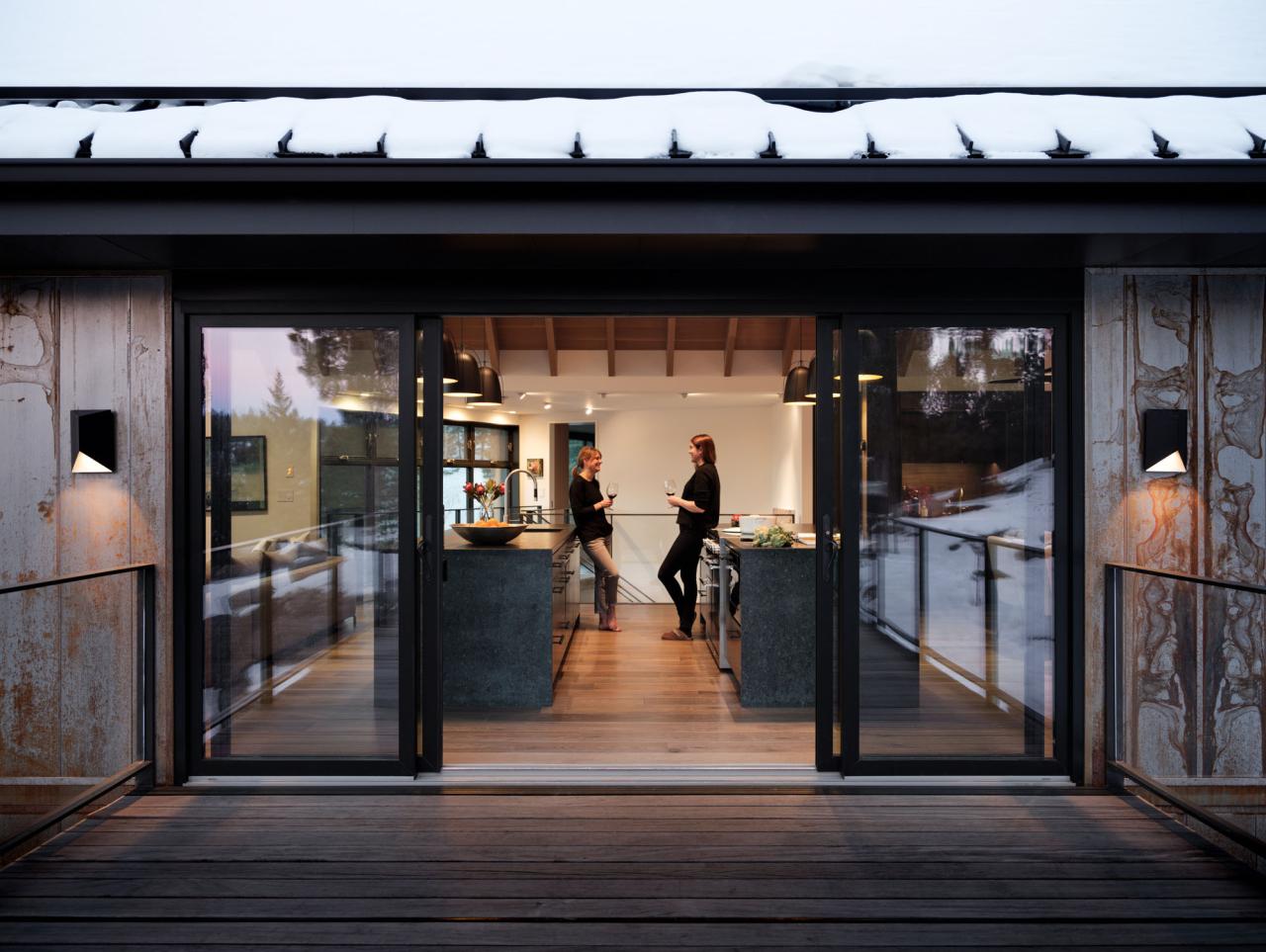
Source: aiacolorado.org
Mountain modern cabins are all about a sleek aesthetic, but that doesn’t mean you can’t incorporate some cool textures. Think about using Textured finishes like wood planks, stone, or even woven materials to add visual interest and warmth to the space. This helps create a cozy, yet contemporary feel that’s perfect for a mountain retreat.
Mountain modern cabins prioritize both aesthetic appeal and practical living. A well-designed layout ensures the cabin seamlessly blends with the natural surroundings while providing a comfortable and functional space for all activities. Careful consideration of the flow, placement of key areas, and integration of indoor-outdoor spaces is crucial for maximizing the experience.
Typical Layout
The layout of a mountain modern cabin often revolves around maximizing natural light and views. Open floor plans are common, connecting the living, dining, and kitchen areas to create a spacious and inviting atmosphere. Bedrooms are frequently positioned to offer privacy and stunning mountain vistas. The design often incorporates multiple seating areas, allowing for flexibility in use.
Open Floor Plans
Open floor plans are a defining feature of mountain modern cabins. These designs create a sense of spaciousness and connection between different living areas. Careful consideration of furniture placement and spatial division is essential to maintain a sense of flow without sacrificing privacy. High ceilings and large windows are often used to amplify the sense of openness and embrace the surrounding natural beauty.
Space Optimization for Activities
Optimizing space for various activities is key. A well-placed fireplace in the living area becomes a focal point for relaxation. The kitchen can be designed with an island or peninsula to facilitate cooking and casual dining, with a clear view of the dining and living areas. The layout should incorporate designated areas for entertaining, with space for guests and flexible configurations.
Key Area Placement
Strategic placement of key areas is crucial for maximizing natural light and views. Living areas are frequently positioned to take advantage of mountain vistas, while bedrooms are often placed to provide privacy. The kitchen and dining areas should be designed to maximize light and interaction with the surrounding landscape.
Integration of Outdoor Spaces
Seamless integration of outdoor living spaces with the interior is crucial for enhancing the mountain cabin experience. Large windows, sliding glass doors, and outdoor patios or decks offer seamless transitions between indoor and outdoor spaces. The use of similar materials and color palettes between interior and exterior designs creates a harmonious aesthetic. Outdoor fireplaces or seating areas can extend the living space and create an extension of the interior, extending the enjoyment of the mountain air and views.
Furniture designed for outdoor use allows for comfortable relaxation, extending the enjoyment of the mountain environment. Carefully chosen landscaping and outdoor lighting enhance the ambiance and functionality of these spaces.
Materials and Finishes
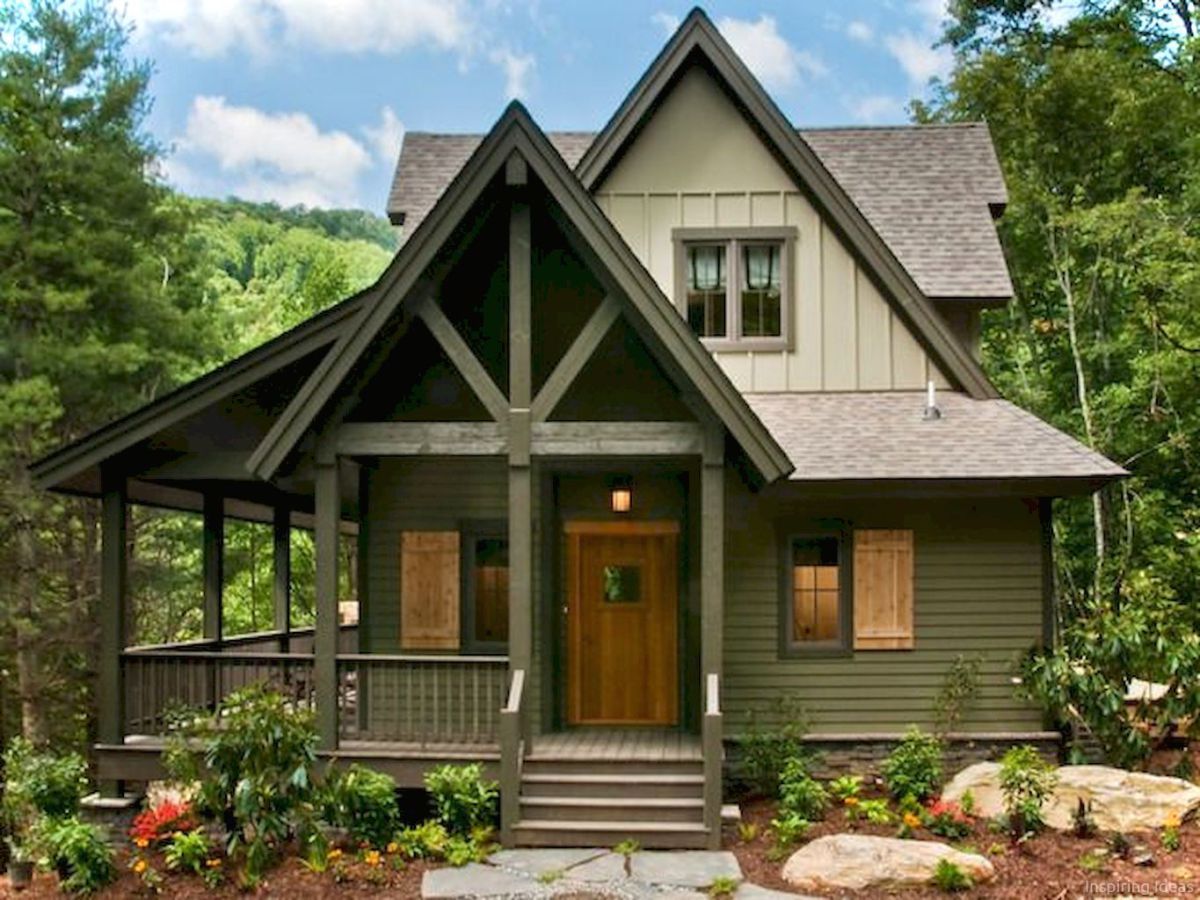
Source: pinimg.com
Choosing the right materials and finishes is crucial for creating a mountain modern cabin that’s both beautiful and functional. The materials selected should reflect the rugged beauty of the mountain landscape while also providing durability and longevity in a challenging environment. Consideration must be given to the cabin’s location, the prevailing climate, and the desired aesthetic.The selection of materials for a mountain modern cabin must balance the desire for a contemporary aesthetic with the need for resilience.
Sustainable and eco-friendly choices are increasingly important, offering a positive impact on the environment while maintaining the high standards of modern design. The appropriate finishes will protect the materials, enhance the cabin’s visual appeal, and ensure its long-term performance.
Common Materials in Mountain Modern Cabin Construction
Selecting materials for a mountain modern cabin is a balance of aesthetics, durability, and sustainability. Popular choices include:
- Wood: Wood is a classic choice for mountain cabins, providing warmth and natural beauty. Different types of wood offer varying levels of durability and aesthetic appeal. For example, cedar is known for its resistance to rot and insects, while pine offers a more affordable option. However, wood requires regular maintenance and protection from the elements.
- Stone: Stone, especially locally sourced varieties, adds a rustic and substantial element to the design. Its natural texture and color variations provide visual interest and character. However, stone can be heavy and expensive, and its installation requires specialized expertise.
- Metal: Metal, like steel or copper, offers a modern touch and can be used for roofing, siding, or accents. Metal is highly durable and resistant to weather, requiring less maintenance than wood or stone. However, the cost can be higher compared to other options, and the appearance might not suit all design aesthetics.
- Concrete: Concrete provides a strong and durable foundation and can be used for walls, floors, and other structural elements. It is highly versatile and allows for a range of finishes, from polished to textured surfaces. However, concrete may not always fit the aesthetic of a mountain cabin if not carefully considered.
Advantages and Disadvantages of Materials
Understanding the pros and cons of each material is crucial for informed decision-making.
- Wood: Advantages include natural beauty, warmth, and affordability (for some types). Disadvantages include susceptibility to rot, insects, and weathering, requiring regular maintenance and treatment.
- Stone: Advantages include durability, natural beauty, and visual interest. Disadvantages include high cost, weight, and the need for specialized installation.
- Metal: Advantages include durability, weather resistance, and low maintenance. Disadvantages include higher cost than some alternatives and a potentially stark appearance that may not suit all styles.
- Concrete: Advantages include strength, durability, and versatility. Disadvantages may include a lack of natural aesthetic appeal if not carefully finished, and a potentially high cost if specialized finishes are required.
Sustainable and Eco-Friendly Options
Sustainability is increasingly important in cabin design.
- Recycled materials: Using reclaimed wood, metal, or stone can significantly reduce environmental impact. Reclaimed wood adds character and can be a cost-effective alternative.
- Locally sourced materials: Using locally sourced materials reduces transportation emissions and supports local economies. This also ensures materials are suitable for the local climate.
- Low-VOC paints and finishes: Opting for low-volatile organic compound (VOC) paints and finishes minimizes harmful emissions into the air.
Selecting Finishes for Different Areas
Appropriate finishes enhance the cabin’s aesthetic and protect the underlying materials.
- Exterior finishes: Exterior finishes should be weather-resistant and durable, considering the local climate. Examples include stain for wood, sealant for stone, and protective coatings for metal.
- Interior finishes: Interior finishes should complement the cabin’s design and be easy to maintain. Examples include paint, wallpaper, or natural wood finishes for walls and floors.
Sustainability and Cost-Effectiveness Comparison, Mountain modern cabin
This table provides a comparison of various materials based on sustainability and cost-effectiveness.
| Material | Sustainability | Cost-Effectiveness |
|---|---|---|
| Reclaimed Wood | High | Moderate to High |
| Locally Sourced Wood | Medium | Moderate |
| Metal | Medium | High |
| Stone | Medium | High |
| Concrete | Low | Moderate |
Furnishings and Decor
Mountain modern cabins prioritize a blend of rustic charm and contemporary style. Furnishings play a crucial role in achieving this balance, offering both comfort and aesthetic appeal. The right pieces can enhance the cozy atmosphere while maintaining a clean, modern aesthetic.Furnishings should evoke a sense of place, drawing inspiration from the natural surroundings. Warm woods, natural textures, and strategically placed accents create a cohesive and inviting environment.
This integration of nature’s beauty with modern design principles is key to the mountain modern aesthetic.
Furniture Styles
Furniture selection is a cornerstone of a successful mountain modern cabin design. The right furniture choices can elevate the space, reflecting both the outdoorsy nature of the mountain environment and the contemporary aesthetic. Different furniture styles can complement the desired atmosphere. This section details the ideal furniture styles for mountain modern cabins.
| Style | Description | Suitable Elements |
|---|---|---|
| Rustic Modern | Blends raw, natural materials with clean lines and modern functionality. | Solid wood pieces, exposed beams, leather accents, occasional armchairs. |
| Scandinavian Modern | Emphasizes simplicity, functionality, and natural light. | Light-colored wood, simple shapes, woven textiles, comfortable seating. |
| Industrial Modern | Combines metal accents with warm wood tones. | Metal legs, exposed brick or concrete, leather or distressed wood pieces, pendant lighting. |
| Bohemian Modern | Combines eclectic patterns and textures with a clean, minimalist approach. | Macrame wall hangings, patterned textiles, woven baskets, statement rugs. |
Incorporating Unique and Stylish Furnishings
Adding personality to the space is vital. This involves incorporating unique pieces that reflect the homeowner’s style and interests while maintaining the overall modern aesthetic. Focus on quality craftsmanship and unique details. This might include a handcrafted wooden coffee table, a vintage armchair with a modern update, or a piece of local art incorporated into the design.
Lighting Fixtures
Lighting is crucial in setting the mood and highlighting architectural features. Unique and stylish lighting fixtures can elevate the design. Consider options like pendant lights with metal or wood accents, statement sconces, or string lights for a warm, inviting ambiance. Think about using natural light as much as possible, and choose lighting that complements the existing color palette.
- Pendant Lights: Metal pendants with a warm, brass or copper finish, or industrial-style pendants with exposed bulbs can add a modern touch. Pendant lights can create a focal point in a dining or living area.
- Sconces: Sconces offer both ambient and task lighting, particularly effective in hallways, or above a fireplace. Consider options with a clean, modern design, incorporating wood or metal elements.
- String Lights: String lights are perfect for adding a touch of rustic charm and warmth, particularly in dining areas or outdoor patios. Choose warm white or soft yellow bulbs for a cozy feel.
Local Art and Crafts
Local art and crafts provide a unique touch and demonstrate support for the community. Display artwork from local artists, handcrafted pottery, or woven textiles in strategic locations. This helps create a personalized and authentic atmosphere, showcasing the area’s unique cultural heritage. The integration of local artwork can enhance the overall aesthetic of the cabin.
Outdoor Spaces
Mountain modern cabins often prioritize seamless integration of indoor and outdoor living. Outdoor spaces are not just extensions of the home but integral parts of the overall experience, offering opportunities for relaxation, entertaining, and enjoying the surrounding mountain scenery. Careful design considerations ensure these spaces enhance the cabin’s aesthetic and functionality.Outdoor living areas, from decks and patios to fire pits, are crucial to a mountain modern cabin’s appeal.
Their design should complement the cabin’s architecture, using similar materials and color palettes to maintain a cohesive aesthetic. Integrating these elements effectively creates a unified and inviting space.
Outdoor Living Areas
Outdoor living areas are more than just places to put furniture. They’re extensions of the living space, designed for both relaxation and social interaction. Careful consideration of materials, furniture, and lighting ensures the spaces blend seamlessly with the cabin’s design. Decks and patios, for example, should be constructed using durable materials like treated lumber or composite decking, complementing the cabin’s exterior.
Fire Pits and Outdoor Kitchens
Fire pits are a popular feature, providing warmth, ambiance, and a focal point for gathering. They can be incorporated seamlessly into the design by using similar materials to the surrounding hardscaping or by incorporating a design element that echoes the cabin’s architecture. Outdoor kitchens add a practical and stylish element, offering convenience for preparing meals and drinks outdoors.
They can be built into the design of the patio or deck, integrating seamlessly with the surrounding environment.
Outdoor Lighting
Effective outdoor lighting is crucial for safety and ambiance. Landscape lighting should highlight key features, such as trees, pathways, and the cabin’s exterior design, creating a welcoming atmosphere. String lights, lanterns, and pathway lighting can be strategically placed to enhance the mood and provide safety at night. Consider warm-toned lighting to create a cozy atmosphere.
Landscaping
Landscaping plays a significant role in creating a balanced aesthetic. Consider native plants that thrive in the mountain climate, contributing to the overall design’s natural beauty. This can involve carefully chosen ground cover, shrubs, and trees that complement the surrounding landscape, maintaining a sense of harmony with the natural environment. Paths and walkways should be thoughtfully designed, ensuring they seamlessly integrate with the landscaping and provide easy access to outdoor living areas.
Maximizing Outdoor Living Areas
Maximizing outdoor living areas for entertaining and relaxation requires careful planning. Consider furniture that is comfortable and durable for both casual seating and dining. Strategically placing seating arrangements around the fire pit or outdoor kitchen encourages interaction. Ensuring adequate space for guests and providing shaded areas can enhance the comfort of the outdoor space.
Outdoor Furniture and Materials
| Furniture Type | Material Options | Considerations |
|---|---|---|
| Dining Sets | Treated wood, composite wood, wrought iron, teak | Consider the style of the cabin and the surrounding landscape when choosing the material and style of the dining set. |
| Lounge Seating | Wicker, rattan, outdoor fabric, teak | Choose comfortable and durable materials that can withstand the elements. |
| Fire Pit Surrounds | Stone, concrete, brick | Select materials that complement the overall design and withstand the elements. |
| Outdoor Tables | Treated wood, composite wood, glass, metal | Ensure the table’s material is durable and complements the surrounding furniture and landscape. |
Sustainable Design: Mountain Modern Cabin
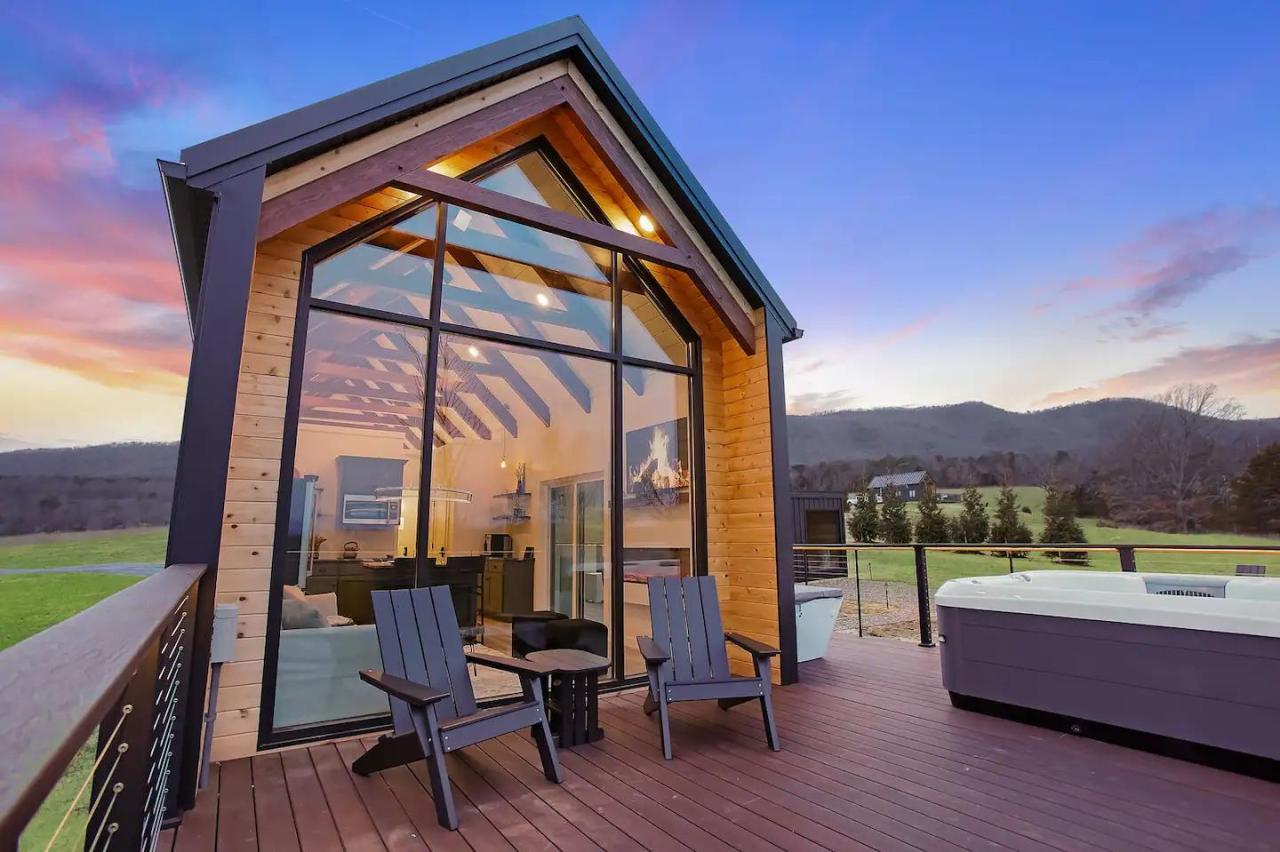
Source: tinyhousetalk.com
Sustainable practices are crucial for mountain modern cabins, integrating environmentally conscious choices into the design and construction process. This approach not only minimizes the cabin’s impact on the natural surroundings but also enhances its long-term value and appeal to environmentally aware homeowners.Embracing sustainability goes beyond just aesthetics; it’s about minimizing environmental footprint throughout the entire lifecycle of the cabin, from materials selection to energy efficiency and waste management.
This means utilizing resources responsibly, employing eco-friendly building techniques, and considering the cabin’s impact on the surrounding ecosystem.
Local Materials and Craftsmanship
Utilizing locally sourced materials is a cornerstone of sustainable mountain cabin design. This approach supports local economies, reduces transportation emissions, and often leads to unique and high-quality construction. For instance, using timber from sustainably managed forests ensures that the wood comes from responsibly harvested sources, not jeopardizing the local ecosystem. Employing local artisans and craftspeople further strengthens the community and provides jobs, which contributes to a vibrant local economy.
Mountain modern cabins are all about sleek lines and natural materials, but the design principles also translate well to a modern beach house, like the ones found at Modern beach house. The open floor plans and emphasis on maximizing natural light make both styles feel airy and spacious. Ultimately, both cabin and beach house designs prioritize a connection to nature while embracing contemporary aesthetics.
Energy-Efficient Building Techniques
Energy efficiency is paramount in sustainable cabin design. Several techniques can significantly reduce energy consumption. Passive solar design, for example, optimizes the cabin’s orientation to maximize natural light and heat gain during winter. Employing advanced insulation methods, such as high-performance insulation materials and airtight construction, reduces heat loss and gain, minimizing reliance on heating and cooling systems.
Proper ventilation systems, such as cross-ventilation and strategically placed windows, can also enhance air circulation and reduce the need for mechanical ventilation.
Eco-Friendly Design Choices
Choosing eco-friendly materials and finishes plays a vital role in minimizing the environmental impact of the cabin. Using recycled or reclaimed materials for construction and furnishings reduces waste and conserves resources. For example, reclaimed wood can provide a unique aesthetic while supporting sustainable practices. Selecting low-VOC (volatile organic compound) paints and finishes is crucial for indoor air quality, reducing exposure to harmful chemicals.
Water-based paints, sealants, and finishes are more environmentally friendly alternatives. In addition, opting for energy-efficient appliances and lighting fixtures can contribute significantly to lower energy consumption.
Mountain modern cabins are all the rage right now, offering a cozy escape in stunning scenery. They often feature sleek lines and sustainable materials, just like a tiny modern house, which are a great option for those looking for a small footprint. Tiny modern house designs often prioritize efficiency and functionality, concepts that can also be applied to a mountain cabin, making it a beautiful and practical retreat.
Ultimately, the best modern cabin is one that blends style, comfort, and sustainable living.
Impact of Insulation and Ventilation
Proper insulation and ventilation directly affect the energy consumption of the cabin. Adequate insulation minimizes heat loss in winter and heat gain in summer, reducing the energy needed for heating and cooling. Proper insulation also enhances the comfort and well-being of the inhabitants. Efficient ventilation, including natural ventilation strategies, promotes healthy indoor air quality and reduces reliance on mechanical ventilation systems, which can contribute significantly to energy savings.
The strategic placement of windows and the use of natural ventilation can significantly reduce the need for air conditioning. These features contribute to a more comfortable and energy-efficient living space.
Final Review
In conclusion, a mountain modern cabin offers a compelling blend of rustic and modern design elements. By thoughtfully considering interior and exterior design, materials, and layout, you can create a space that reflects your personal style while maintaining a harmonious relationship with the natural environment. Whether you’re seeking a cozy retreat or a stunning entertainment space, a mountain modern cabin provides a versatile and captivating solution.
Helpful Answers
What are some common sustainable materials used in mountain modern cabins?
Sustainable options often include reclaimed wood, bamboo, and local stone. These materials not only enhance the aesthetic but also minimize the environmental impact.
How do you maximize natural light in a mountain modern cabin?
Large windows and strategically placed skylights are key to bringing in natural light and creating a bright, airy feel. The positioning of these windows also helps maximize stunning mountain views.
What’s the difference between a mountain modern cabin and a rustic cabin?
A rustic cabin often emphasizes raw, natural materials and a more traditional layout. Mountain modern cabins, on the other hand, feature a more refined and contemporary aesthetic, often with clean lines and modern finishes.
What are some key considerations for integrating outdoor living spaces?
Think about seamless transitions between indoor and outdoor areas. Consider covered patios, decks, fire pits, and outdoor kitchens to extend your living space and create an inviting atmosphere for entertaining.
- Pivot Glass Doors A Stylish Choice - June 2, 2025
- Mountain Modern Cabin A Stylish Retreat - May 6, 2025
- Modern Loft House A Stylish Home - May 6, 2025




